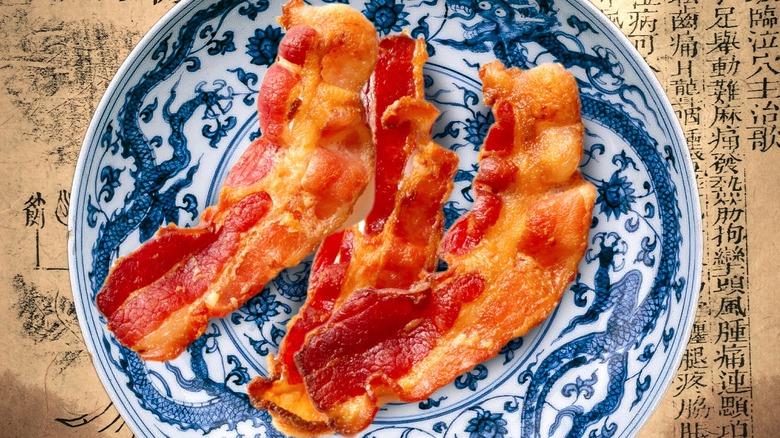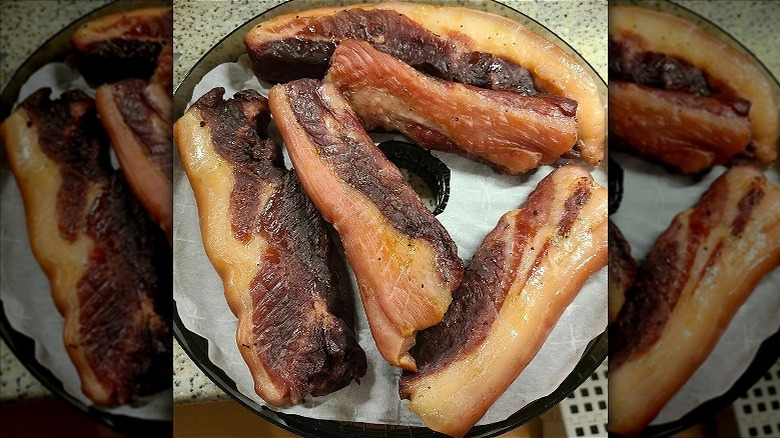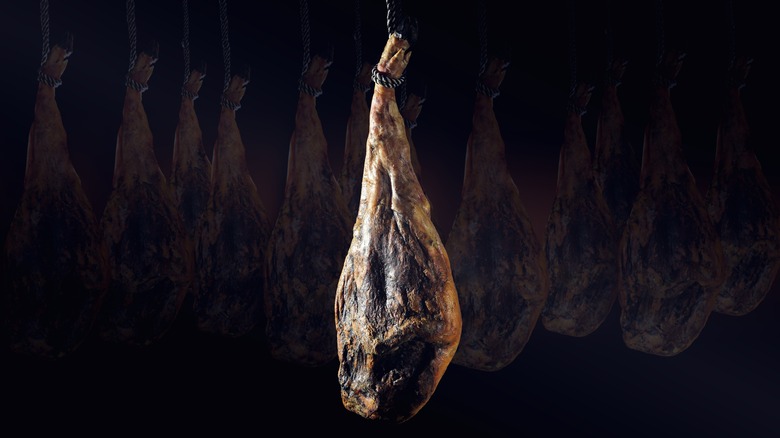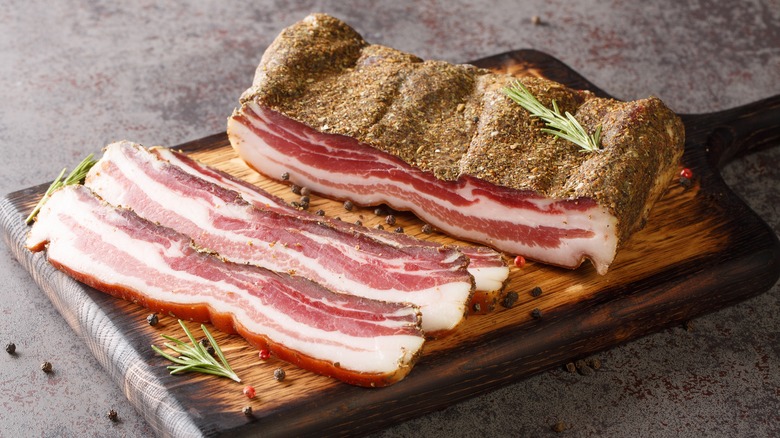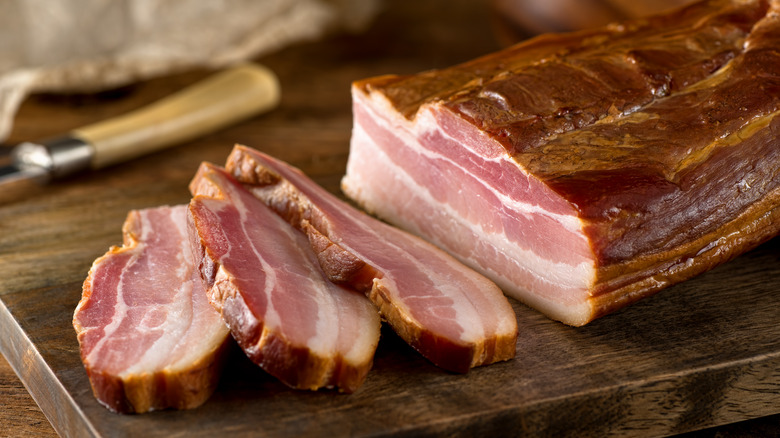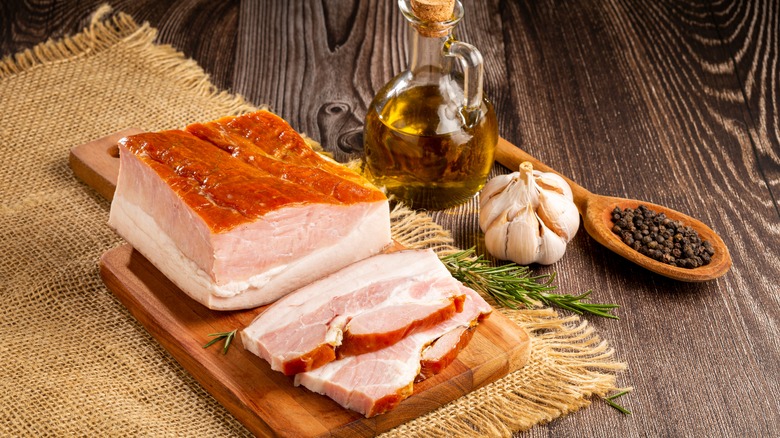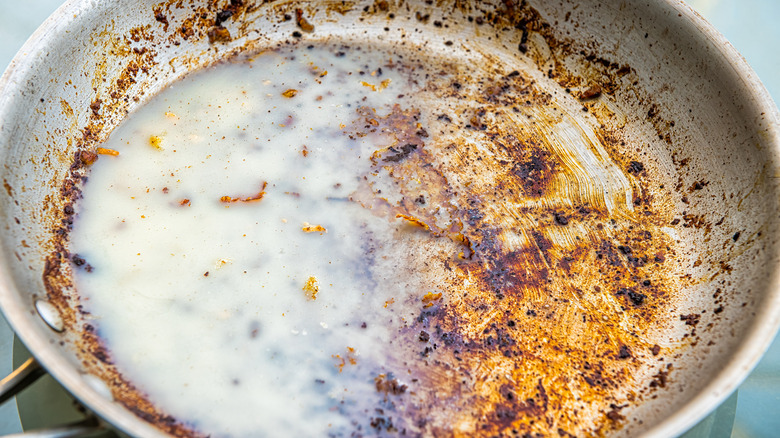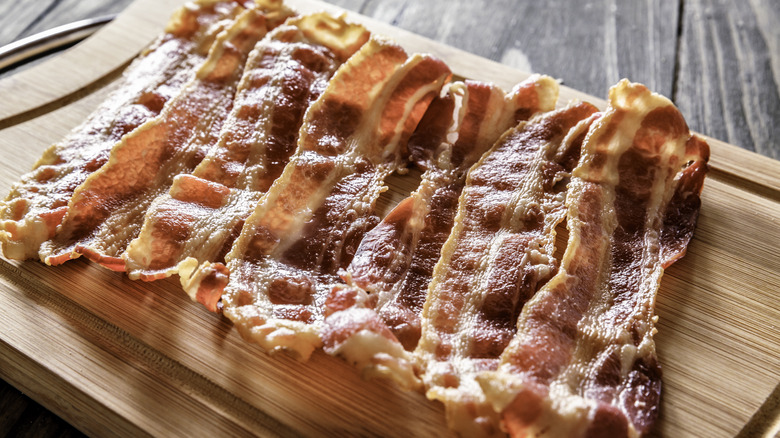The Truly Ancient Chinese Origins Of Everyone's Favorite, Bacon
Bacon is big business in the U.S., with an estimated $6.5 billion in sales annually, according to The National Provisioner. Even with increased awareness regarding health, environmental, and economic impacts associated with meat consumption, bacon remains one food that enjoys an almost cult-like following. This porcine delight finds its way into virtually every meal and every recipe, both sweet and savory; we eat throughout the day. And while purists insist on consuming classic, thick-cut, smoked bacon, the demand for specialty bacon, like uncured, flavored, and vegan offerings, is growing.
Considering how pervasive bacon is within our culture, did you ever stop to ponder where bacon comes from and how it became so popular in America today? We certainly have. The history of your favorite meaty delight might surprise you. While bacon may seem as American as apple pie, it was born in China, taking a somewhat circuitous route to America. Let's look at the ancient Chinese origins of everyone's favorite meaty delight — bacon.
Bacon appears in China
No discussion about bacon can begin without talking about pork. Pigs appeared approximately 2 million years ago in modern-day Southeast Asia. Early pigs resembled wild boars with aggressive personalities and large, razor-like tusks, making them unruly to hunt. It wasn't until about 10,000 B.C. that pigs became domesticated, slowly adapting them to be less dangerous and easier to handle. By 1,500 B.C., the Chinese discovered they could preserve pork using the abundant salt harvested from industrial salt mines in the central village of Zhongba, China.
From these early cured pork products emerged what is known in Cantonese tradition as Lap Yuk, or old Chinese bacon. Centuries ago, villagers of southwestern China would take their slaughtered pigs and cure, smoke, and age the pork belly to help preserve it. This would ensure a reliable food source throughout the year. While individual recipes for Lap Yuk are as diverse as the people of China, many variations have an umami-rich saltiness from soy sauce balanced with a hint of sweetness from rice wine. The result is toothsome bacon that can get cut up and tossed into any number of dishes, from stir-fries to dumplings. Lap Yuk is particularly revered as a traditional food consumed during the Chinese New Year.
Bacon arrives in ancient Rome and Greece
It is presumed that the process of curing pork was picked up by Roman and Greek conquerors. In ancient Greece, the word for ham was kolén or perna, referring to the hind legs of a pig. In Rome, it was known as petaso, referring to the pig's shoulder. The side portion of the pig, which was most similar to modern-day bacon, was known as the lardum to the Romans and halistón to the Greeks. The Romans took the process of raising, slaughtering, and curing pork extremely seriously, developing techniques to reduce the amount of lactic acid in the meat and decrease its acidity, thereby rendering it far less susceptible to rotting.
Pork would be processed in the fall or winter once the pigs had sufficiently bulked up. Before slaughter, the pigs were not fed or given water. Once slaughtered, the meat was left with skins intact to prevent it from becoming overly dehydrated. This would get layered in a vat and covered with salt in alternating batches. These would get rotated after five days and allowed to cure for an additional seven days, after which the cured hams were hung to dry for two days. This meat was rubbed with oil and smoked before being preserved in oil and vinegar. Similar processes were adopted in Greece. Once the lardum was processed, it would get consumed raw or cooked with broad beans as a delicacy on special occasions. It also became a staple provision to Roman soldiers thanks to its shelf-life.
Medieval Bacon
Much of the information regarding bacon production from the Medieval period hails from England. The etymology of the modern word for bacon comes from the Middle English bacoun, which typically referred to salt-cured pork made from the loins or bellies of the Yorkshire and Tamworth breeds of pig, known as bacon breeds. Bacon, and pork in general, was the primary food source, particularly for lower-class families, thanks to its affordability and ease of production.
The bacon of the Medieval period was always salt-cured, generally under compression, and then hung out to dry. Sea salt was preferred because it was readily available and cheap. Compression was commonly used as it would more rapidly remove moisture from the curing meat, preventing it from becoming rancid. Drying would extend its shelf-life, making it safe to store at room temperature.
This bacon would either get rehydrated before cooking it or cut into smaller pieces and added to a dish, giving it both meat and salty flavor. Bacon was never sugared or smoked during this era, as the danger of smoking going awry and ruining the meat was something only the wealthy could afford to do. The primary characteristics of the dehydrated bacon were that it was hard and grayish in color, similar to salted fish. People used their noses to determine the safety of bacon. If it smelled off, it was unsafe to eat. If it had no odor, it was safe.
17th-century bacon
The 17th century marks the introduction of bacon as we know it today, namely bacon cured using sugar, potassium nitrate, known as saltpeter, and smoked. Early on, only cold smoking was recommended as hot smoked meat was particularly susceptible to bacteria if not carefully processed. With the introduction of high levels of saltpeter, the risk of contamination with hot smoking was lessened, enabling smoked bacon to become the norm by the 18th century rather than the exception reserved for the elite class.
A note about saltpeter: Before the 17th century, saltpeter was revered for its use in gunpowder and medicinal purposes. It was seldom used for culinary endeavors, likely because it would have been far more valuable for ammunition. Saltpeter was initially harvested by saltpeter men throughout the English countryside, particularly in areas known to be populated by human or animal dung.
As saltpeter became more commonly used for culinary purposes, England could not sustain an adequate supply for their needs, necessitating its importation, predominantly from India, via the Dutch East Indian Company. At that time, saltpeter was the most traded commodity by volume. Saltpeter is known to be toxic in amounts larger than four grams. Bacon recipes from the mid-1700s were considered highly nitrated, with up to 10% by volume. By the end of the 1700s, saltpeter use dwindled to approximately 3.3%. Even at these levels, they were well below what was considered dangerous.
Bacon comes to the New World
As bacon production evolved in England, it slowly spread across the Atlantic Ocean to the New World. The first batch of pigs arrived in Cuba in 1492, along with explorer Christopher Colombus. Queen Isabella of Spain suggested he bring eight specimens along on his voyage. The arrival of pigs to mainland soil didn't occur until 1539, when "the father of the American pork industry," as he has been dubbed by the National Pork Board, Hernando de Soto, arrived in Tampa Bay with 13 pigs in tow.
In the 3 years before his death, this herd of pigs grew 700 strong, quickly spreading across the mainland. These razorback feral pigs eventually reached as far north as Manhattan Island by 1653, running wild within modern-day New York well into the 19th century.
The mass production of bacon, based upon the invention of a brine-curing process known as the Wiltshire cure by Englishman John Harris in the 1770s, began to thrive in earnest in America. By the 1870s, Cincinnati, Ohio, was known as Porkopolis, while Chicagoans were processing over a million heads of pigs per year. In 1883, German brothers Oscar and Gottfried Meyer began their first meat-packing plant with just $10,000, solidifying the U.S. as the center of bacon production.
Bacon in the 20th century
Bacon was integral as a food item in America in the 20th century. During World War I, it was the go-to fat for cooking in the home until commercially produced lard began replacing it much later. In 1924 Oscar Meyer began selling the first commercially produced pre-packaged and pre-sliced bacon, turning it from a humble home staple to a mass-market commodity. It wasn't until World War II that bacon met its ultimate destiny — as a resource of fuel for making bombs.
In fact, 1 pound of bacon grease had a high enough glycerin content to create a 1-pound explosive device, leading the government to begin a campaign encouraging women to exercise their patriotic duties and save their cooking grease for America. They were instructed to collect all excess cooking fat in a wide-mouthed can.
The moment a full pound of cooking fat was collected, this can of fat would get turned into butchers, meat dealers, and frozen food plants who would give the grease to the army. One can of cooking fat was worth four cents to the donor. And in 1943, when food rationing began, the government increased the incentive to save grease by throwing in two ration points for each pound of cooking fat. Despite these incentives, only roughly half of all American women participated in the grease collection program.
Bacon in the modern era
Though the popularity of pork and bacon ebbed and flowed during the 20th century, by 2015, pork overtook beef as the top meat consumed by Americans, thanks to the spike in the popularity of bacon. While the phrase, bring home the bacon dates back to the 12th century, when a church in Dunmow, England, promised any couple who could prove they hadn't had an argument for a year and one day would receive a side of bacon Americans literally bring home the bacon, to the tune of roughly 18 pounds per person a year.
Bacon today is an integral aspect of popular culture. From commercials to bacon-scented candles to a bust of Kevin Bacon made out of bacon. You almost cannot escape it. In fact, if you want to really worship bacon, you can join the United Church of Bacon in Las Vegas, Nevada. Don't believe us? The organization was established in 2010, boasting over 30,000 bacon-loving members globally.
While it is predominantly a non-profit organization that raises money for causes, including research for AIDS and cancer, autism awareness, anti-discrimination, and education, it also hosts weddings. You can get ordained to officiate a bacon-themed wedding through their website. And for social media devotees, there is no shortage of bacon-focused content and groups to follow.
